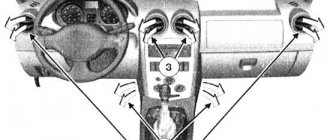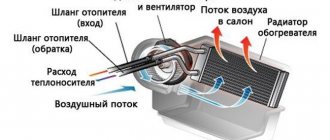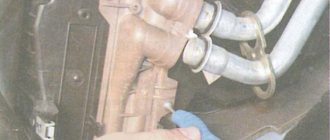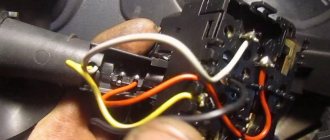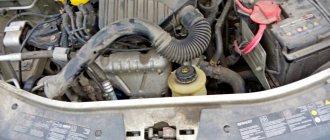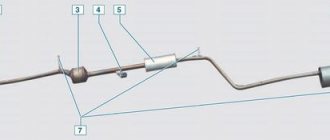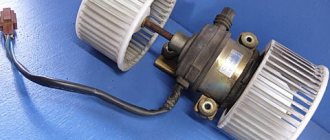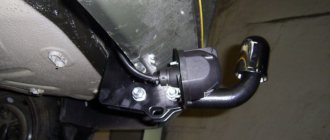Removing and replacing the Renault Logan heater fan without dismantling the instrument panel
With a broken stove, people in the car feel uncomfortable, both in winter and in summer. The stove is required to create a comfortable temperature; it is used to get rid of condensation on the glass; without it, the stability of the engine may be impaired. More often than not, the heater motor fails, and the popular Renault Logan car is no exception. You can solve the problem of replacing the motor yourself.
The heater motor for Renault Logan is supplied by two companies - Renault directly and a third-party manufacturer Valeo, both of them are considered original. Modifications are offered for cars with and without air conditioning. The first ones have a little more power, otherwise their design is identical, so repair and maintenance are no different.
Renault Logan heater motor replacement: we’ll describe it in detail
Renault Logan is one of the most commercially successful models of the French concern. It is produced in seven countries and sold almost all over the world. It’s not for nothing that the car has earned the love of car owners. It is compact but roomy, handles well, is cheap to operate and surprisingly reliable. However, even the most reliable cars have breakdowns. In harsh Russian winters, a malfunctioning stove can become a serious problem. If the heater motor fails, repairs at the service center can be expensive for the Logan owner. However, you can save a lot of money by replacing this unit yourself.
Signs of a faulty Renault Logan heater motor
More often, the cause of a stove motor breakdown is wear and tear of parts over time, since rings, brushes and other moving parts will sooner or later fail. Less common are problems of an eclectic nature - oxidation of contacts or broken wires. Often the lubricant on the moving parts of the motor and fan simply runs out.
Signs that the Renault Logan heater fan is working in abnormal mode and the unit will soon fail can be determined by certain signs:
- the stove changes the sound during operation, the noise increases;
- the heat flow becomes uneven and weakens;
- The stove does not turn on the first time or takes a long time to gain momentum.
The stove whistles when operating
A whistle is heard from under the central panel and is a sign that the heater motor bearing has failed and if the motor is removed, you can see that the bearing has noticeable play on the shaft. Such a whistle indicates that the stove will soon break down and it is better to replace it. Sitting in the cabin becomes not very pleasant; the monotonous whistle is very tiring. If you simply lubricate the mechanism, this will not eliminate the problem for a while, but the whistling will inevitably resume.
The stove turns on poorly or does not turn on at all
On older versions of Logan, the stove simply stops turning on. If you hit the surface of the console on the right side, it began to work, sometimes with a characteristic noise. There are several reasons for the mechanism to jam:
- Throwing in a loose bearing.
- Development on the shaft.
- Lack of lubrication on mechanisms.
- The motor brushes are worn out.
Reduced air flow from the stove
This problem occurs when the curtains on the center panel are fully open. During the cold season, even with full power, the car still remains cold. The driver notices the problem only after a while; the windshield may not freeze at sub-zero temperatures, limiting visibility. Often in the fourth position the air flow is less intense than in the second.
The main reason for such a breakdown is a problem with the motor. Less commonly, the cabin filter is clogged. In this case, you need to disassemble the stove and inspect the engine and cabin filter. Only then will it be possible to identify and eliminate the cause of the malfunction.
What to do if the heater does not work on a Renault Logan
The design of one of the most advanced cars of our time, Renault Logan, was, unfortunately, not without several “bottlenecks”, which can sometimes manifest themselves negatively, creating certain inconveniences for the driver and passengers. Among these potential problem areas is the heating system, which was designed using a standard method. It consists in the fact that the heater radiators are connected directly to the automotive cooling system. Therefore, there is a constant circulation of the flow of hot coolant, and the flow of warm air into the air ducts is regulated by a special damper. For a number of reasons, the Renault Logan stove sometimes begins to work ineffectively, or even fails altogether.
This material is entirely devoted to this pressing issue, analyzing why the Renault Logan stove does not work and how exactly to correct this deficiency on your own.
So, we should move on to consider the features of why the stove does not work on a Renault Logan:
- Air filter clogged.
- The resistance has failed.
- Fuse F36 faulty.
- Plug contacts are faulty.
- Fan switch failure.
- Incorrect position of the air control damper, etc.
We will look at these reasons in more detail below.
One of the most common causes of functional failure of the stove in practice is a clogged cabin air filter. Its location often leads to various foreign objects entering it from the outside, including tree leaves and insects. This leads to a sharp decrease in the flow of hot air directed into the cabin. Therefore, experienced drivers usually begin repairing the stove with a thorough inspection of the filter housing. It is located in the cabin under the bottom of the front panel, near the location of the passenger's left foot. If the filter is really clogged, clean it by throwing away all foreign objects and carefully cleaning the inside of the housing.
Quite often in practice there are incidental cases when the heating fan operates normally at all speeds (1st, 2nd and 3rd), except for the fourth. In such situations, the reason for the abnormal operation of the Renault Logan stove is, as a rule, the resistance: it has failed for various reasons and needs to be replaced with a new one.
If the stove fan does not want to turn on at all, an almost unambiguous diagnosis is a malfunction of fuse F36. Most likely it is burnt out and needs to be replaced with a new one. However, when checking it, it also happens that the fuse is intact and functional, but the fan stubbornly does not turn on. Then the fan relay must be checked: it is replaced, after which the stove often begins to operate normally in normal mode.
But, unfortunately, a third option is also possible. So, the relay has been replaced, but the stove has not resumed normal operation. Here you cannot do without checking the contacts of the plug that supplies voltage to the fan motor. To test the motor itself, it must be directly connected to the battery using an open plug. If the electric motor is working properly, the reason may be in the fan operating format switch, but if it works, you cannot do without removing and checking the commutator brushes.
Also interesting: How to make a Niva spar amplifier
It is necessary to highlight another widespread cause of malfunction of the Renault Logan car heater. Practice has shown that this cause in many cases is the air control damper, which blocks the flow of hot air into the cabin. Here you need to immediately check the functioning of the cable wire enclosed in a white protective sheath, since, according to statistics, in the vast majority of situations it is the culprit.
The article examined the main formats of Renault Logan stove malfunctions and algorithms for eliminating the causes of the breakdown on your own. Of course, it’s much easier to go to one of the reliable service stations so that experienced specialists can handle the repairs, but this option may not be cheap. However, if the driver self-critically understands that he cannot cope with a broken stove alone, willy-nilly he will have to seek help either from a professional partner or from the same service station. Good luck!
Replacing the stove fan yourself
The Logan heater fan is integrated into one unit with the motor, so it is dismantled along with it. Many Renault Logan car owners say that to dismantle it, you need to completely remove the central panel of the car, but there is a way to do this by simply unscrewing two mounting bolts.
To remove the stove fan, first remove the facing of the right pillar, you need to carefully pry it off with a screwdriver and pry off the two latches. It opens the top screw, which is unscrewed with a T20 screwdriver. At the bottom of the panel there is a plastic plug, under which there is another self-tapping screw with the same head. After unscrewing the screws, the plug is closed and the door seal is completely removed so as not to damage them during operation. Afterwards you can remove the fan.
The panel is carefully removed from the guide elements. The Renault Logan heater fan is located under the glove compartment, installed in the air duct. You can see it even if you cannot bend the panel as far as possible; all manipulations are carried out by touch.
First, carefully disconnect the electrical connector, then remove the Renault Logan heater fan. To do this, press the latch and turn it clockwise until it clicks and pull it out of the mount. This pulls back quite a bit on the right side of the dashboard, so you have to be careful not to break the plastic.
The two types of fans differ in connectors and mounting to the case. Replacing the stove fan with a Logan is carried out after dismantling the entire assembly. You remove the cover and see the motor, if it works, just lubricate it with ATF from a syringe. If this does not help, you can ring it, check the brushes, but most likely the heater motor will need to be replaced. After inspection, maintenance or replacement of the unit, it is installed in place in the reverse order.
You can remove and change the heater motor on a Renault Logan yourself. This does not require any special tools or equipment. The only difficulty is that dismantling and reinstallation will need to be done by touch. But with some skill, this does not pose a problem. In order for the new part to guarantee reliability, it is better to buy a heater motor from the original manufacturers, which Renault recommends, there are only two of them. After installation, you need to check the reliability of the panel, the lining of the right pillar and the rubber seal. If this is not done, extraneous creaks and drafts will make the ride uncomfortable.
Video: Replacing the heater fan (stove) for Renault Logan, Sandero, Duster, Lada Largus
Source
Heating system design
It cannot be said that the Renault Logan ventilation and heating system is a weak point, but such a malfunction, especially in the cold season, promises unpleasant consequences. The operating principle of the interior heating system does not differ significantly from the device in other cars. But if the rear window heating does not work, then this can also spell trouble.
The heater radiator is connected directly to the cooling system, in which the coolant circulates (coolant, about replacing it here, about choosing a coolant here), which warms up within 95°C during engine operation. A special fan blows onto the hot radiator, which creates a strong air flow and directs it into the cabin through special air ducts. The quantity and speed of supply of heated air is regulated using a damper.
Signs of a malfunctioning stove
You should think about the upcoming repair and replacement of the stove motor if the following malfunctions are observed in its operation:
- An extraneous noise appeared when the stove was turned on.
- Warm air stopped flowing into the cabin.
- The speed of the incoming air flow has decreased.
- And of course, if the stove does not turn on at all. (However, in the event of such a malfunction, first of all analyze the condition of fuse F36, which is located inside the car. It is located in the green housing and is responsible for short-circuit protection of the heater system).
The fuse responsible for the operation of the stove is located on the right side of the block.
All work will be carried out on the right side of the car.
- Remove the rubber seal from the right front door at the top.
- Using a plastic puller or ruler, carefully remove the right front decorative pillar. It goes from the panel to the ceiling. Attached with latches. It is recommended to carry out repairs in a warm room or when it is quite comfortable outside. This is necessary in order not to break the plastic fasteners: at low temperatures, plastic becomes brittle.
- After removing the stand on the panel from above, you have access to the first screw. We unscrew it with an asterisk.
- The second place for fastening the front panel is under the glove compartment on the right. It is closed with a plastic plug. Remove it carefully with a screwdriver. Unscrew the second screw with a TORX T20 key. All. Now you can manipulate the panel.
- Carefully pull the right side of the panel towards you. We remove it from the guides and stick our hand into the gap formed and feel for the stove fan. It has a round body. You won’t be able to see it, so we do everything by touch. It's a little difficult, but possible.
- Remove the fan by turning the housing clockwise. Turn off the power supply. We take it out from under the panel and inspect it. There are two types of fans. Structurally, they differ from each other slightly: wide or narrow connector.
Do-it-yourself dismantling and replacement of the Renault Logan stove
The stove is an integral part of the heating system of any car. Thanks to this device, comfort is ensured inside the vehicle during the cold season. As coolant circulates through the heater radiator, the air passing through it heats up. Through the fan and air ducts, heat is supplied and distributed throughout the cabin. Only with a fully functioning system will it be warm inside the car, regardless of the weather outside.
How does the stove of a Renault Logan car work?
The interior heating device on the Renault Logan is located under the dashboard in the central part. The main design elements are a fan, dampers for air flow distribution and a radiator. Failure of one or another part leads to partial or complete loss of functionality of the unit. If you are the owner of a Renault Logan, it would be a good idea to understand how interior heating works.
Schematic representation of the Renault Logan stove: 5 - Distribution block; 6 - Heater radiator; 7 - Heater pipelines; 8 — Passenger compartment fan resistor; 9 — Front left air duct for heating the footwell; 10 — Air recirculation control cable; 11 — Air distribution control cable; 12 — Air temperature control cable
Breakdown of the heater motor on Renault Sandero and Renault Logan: characteristic features
To say that the heater in Renault Logan and Sandero is a weak point would be wrong. But, nevertheless, some breakdowns sometimes occur. The stove motor is necessary to rotate the fan. This component is also subject to wear and tear during operation. The stove motor tends to fail not immediately, but gradually, trying to catch the driver by surprise.
Owners of Renault Logan and Renault Sandero, who have ever encountered a similar problem, note that at the first stage, problems with the engine make themselves felt by the fact that the heater begins to heat poorly. Then various extraneous sounds arise during its operation and, ultimately, the stove stops working.
In any case, if the heater stops working, the first thing to do is make sure that it is not caused by a fuse problem or a dead battery. After which you can proceed to a more thorough inspection of the system, including inspection of the motor itself.
Causes of stove malfunction
If it has been noticed that the efficiency of heating the interior of your Renault Logan has decreased, do not immediately panic. First you need to understand in detail what the problem is and find out the reasons. Depending on the nature of the malfunction, the interior heater may work poorly or not function at all. Let's look at the main reasons why the stove's performance is impaired:
- There is an air lock in the heating system.
- Thermostat failure.
- The pump is not working properly.
- The heater radiator is clogged.
- Problems with the heater motor.
Despite the apparent simplicity of solving these problems, they are the ones that most often force car owners to carry out independent repairs or contact a service center.
Why does the Renault Logan stove not heat up?
One of the common problems with the Renault Logan heating system is the lack of warm air from the deflectors, while the stove pipes remain hot. In addition to the reasons listed, the flow of heat into the cabin may be limited due to a clogged cabin filter. Since quite large debris, such as leaves, gets into the cavity of this element, the filter must be inspected and cleaned periodically.
One of the reasons that the heater pipes are hot and warm air does not enter the cabin is an air lock in the system
Common reasons why the stove does not heat include the failure of a resistor or heater fuse. Checking these elements will help determine their integrity and, in case of damage, replace them. If all of the above did not help determine the problem of poor functioning of the stove, check the contacts of the connector through which power is supplied to the fan motor.
Diagnosing the motor itself is quite simple. To do this, it is connected directly to the battery, and if the unit operates at maximum speed, then the reason should be looked for elsewhere, for example, in the electric motor operating mode switch. Attention should also be paid to the dampers; due to improper operation, the process of warm air entering the cabin is disrupted. In this case, the problem may be in the cable that controls the damper.
Location and replacement of the Renault Logan heater resistor
The heater resistor on the Renault Logan is located near the electric motor, in the rear of its housing, i.e. under the panel on the driver's side. The resistor is a white connector with a resistor located to which the wiring harness is connected.
The heater resistor is located at the bottom of the pedal assembly on the right side
How to determine that the resistor has failed? In most cases, the part simply burns out. The reason may be that the fan is dirty or malfunctioning. You can determine that the resistor is broken by the operation of the motor: the unit will function only at fourth speed. Let's now figure out how to replace a burnt out part.
- Remove the negative terminal from the battery.
- We find the connector with the harnesses and, pressing the latches, disconnect it from the failed element.
- Using a T-20 Torx wrench, unscrew the two resistor mounting bolts.
- We move the part up and take it out.
- We replace the resistor with a new one and install it in the reverse order.
Replacing the Renault Logan heater radiator
The need to replace the heater core arises if a leak occurs or the heat exchanger is clogged. As a result, the heating system is unable to supply hot air to the cabin. Since the radiator is a non-repairable unit, it is replaced with a new product. The process is as follows:
- Drain the coolant.
- In the engine compartment, remove the outlet and inlet pipes by loosening the clamps.
In the engine compartment, loosen the clamps of the heater pipes and tighten them
To make dismantling the radiator more convenient, remove the central trim on the instrument panel
The steering column cover and trim will need to be removed from the instrument cluster.
To release the radiator, unscrew the fastening elements of the pipes and the heater itself, and press the clamps
Replacing the Renault Logan heater motor
They resort to replacing or repairing the electric motor of the stove when the unit makes extraneous noise or does not work at all. To dismantle the fan, you will need a minimum set of tools, which consists of various screwdrivers and a Torx T-20 wrench. To remove the motor, you need to unscrew two screws. The procedure is performed in the following sequence:
- Remove the seal from the doorway and the trim of the pillars using a screwdriver.
Before starting to dismantle the heater motor, remove the lining of the pillars
The dashboard is secured with two Torx screws, unscrew them
When the fasteners are unscrewed, pull the panel towards you
Remove the connector from the heater motor and remove the assembly itself
Video: dismantling the heater motor on Renault Logan
How to replace a heater light bulb
In addition to the problems listed above, the heater can cause other inconveniences associated with the lack of lighting when the heating device is turned on. As a rule, the problem is a burnt-out light bulb, which is not difficult to replace. For this:
- Remove the radio cover.
- To dismantle the gray panel, carefully pry it open with a screwdriver.
To remove the gray panel, pry it off with a screwdriver
One of the steps to replacing light bulbs is to remove the heater controls
The plate with the icons is attached to the latches: carefully press them out
The backlight is located under the control panel: bend it and remove the lighting element
After installing the new light bulb, reassemble it in the reverse order.
Video: replacing Renault Logan stove light bulbs
Before the onset of the cold period, it is recommended to check the operation of the Renault Logan stove in all modes. This will allow you to identify possible malfunctions and eliminate them in advance, and independently. After all, at sub-zero temperatures, doing repair work on a car is not the most pleasant pleasure.
Source
DIY Renault Logan stove repair
If a malfunction occurs, it is not necessary to immediately go to the service center. Many breakdowns are not as serious as they seem, and you can handle them yourself. And it is also worth noting that the Renault Logan stove is not completely replaced - it is enough to replace the failed part.
Troubleshooting minor problems
If “alarming symptoms” occur, it is necessary to consistently check the condition of the antifreeze and the vehicle components described above. If air pockets are detected in the system, they must be vented. Clogged filters and caps should be cleaned or replaced. Used antifreeze must be drained and new one added. The expansion tank can also be changed; in this case, it is better to leave the “original” lid - it will hold pressure better.
If the manipulations done do not have an effect, then the problem lies in one of the heater components.
Replacing the heater fan
A sign that the source of the malfunction is the fan (the brushes are worn out or the electric motor is out of order) is a weak air flow from the deflectors or its complete absence. In this case, the fan must be replaced.
Replacing the Renault Logan heater fan is carried out in the following order:
- First you need to remove the instrument panel and find the plastic clip that secures the fan.
First you need to find the clamp that secures the fan.
Disconnect the wires from the fan
Changing the resistor
A sure indicator that it is the resistor that has failed is that the stove fan is only operating at speed four.
The resistor is located at the back of the fan housing. You need to look for it in the area of the pedal assembly (on the right side). This element is a white plastic rectangular “socket” to which a block with wires is attached. Replacing the Renault Logan heater resistor is carried out in the following order:
- Disconnect the terminal of the wire coming from the negative side of the battery.
- Find the block with the wiring harness. Pressing the latches, disconnect the block from the resistor.
Disconnect the block by pressing the latches (1), then unscrew the screw (2)
We remove the resistor with all possible care
Installing a new radiator
Replacing the heater radiator on a Renault Logan is required if coolant begins to leak through it. Replacing a radiator is the most complex and time-consuming process when repairing a car heater with your own hands.
Sequence of actions when replacing the radiator:
- Drain the antifreeze completely.
- Remove the instrument cluster and console trim.
- Remove the carpet fastening to the cross member bracket and bend the carpet back.
First you need to remove the carpet
Unscrew the bracket fastening
Removing the bracket for the Renault Logan heater
Unscrew the screw and remove the radiator tubes
The final stage is to remove the Renault Logan heater radiator mounts
Replacing the heater light bulb
The main problem with a faulty light bulb is that it can signal that the stove is not working, although the heater will function normally.
To change a light bulb you need:
- Remove the radio cover and the buttons that control the operation of the stove.
- Unscrew the fasteners of the module and press in its lower part, and pull the upper part towards you.
- Find the latches on the sides and press them out.
- Unscrew the panel and look for the burnt out light bulb.
- Replace the light bulb and perform all manipulations in reverse order.
The work involves performing actions on the right side of a Renault Logan car.
- We dismantle the rubber seal on the upper edge of the front door.
- Using the puller indicated earlier, we remove the decorative trim on the front (right) body pillar. The design of its fastening assumes the presence of latches. We recommend performing this action in warm weather conditions or in a heated box. This is required in order to avoid breakage of the plastic fasteners of the lining, which become more fragile in cold weather.
- Having dismantled the cover, we gain access to the first screw, which we “defeat” with a “star” wrench.
- The second mounting point for the panel is located below the glove compartment. It is hidden under a plug that should be removed immediately. Now unscrew the screw with a TORX wrench size “20”.
- Carefully place the right side of the front panel towards you. A gap opens, into which we penetrate with our hand and find the heater fan. The element is equipped with a round body. It is not possible to inspect it, so we carry out all actions by touch. Not entirely inconvenient, but possible.
- To remove the fan, rotate its housing in the direction of the clock hand. Disconnect the power supply connector. We remove this unit from under the dashboard and check it visually. Renault Logan has two types of fans, which differ slightly (wide or narrow connector).
Troubleshooting
To troubleshoot a Renault heater, we will try to reveal the essence of each of them.
- An air lock in the Renault heating system can be caused by earlier work to replace antifreeze. Typically, the cooling system is designed to automatically get rid of air pockets. Despite the perfection of this design, air pockets still appear, as a rule, during the process of repairing the cooling system. There is one simple way to eliminate an air lock on a Renault Logan. Disconnect both pipes from the cabin heat exchange, then, connecting each pipe in turn, pour coolant into the expansion tank. After such manipulations, the antifreeze should flow through the opposite tube, at which point you need to insert the second hose into place. Usually after such actions the stove heats noticeably better.
- If the Renault Logan is not installed, the engine does not reach the required operating temperature, as a result of which the coolant is not able to warm up the heater radiator. To solve this problem, it is enough to change the thermostat, fortunately this is not difficult to do. The thermostat housing is located at the bottom of the cylinder head near the gearbox housing.
- If the Renault Logan water circuit pump does not work correctly, it does not produce the proper pressure, coolant cannot flow into the heater radiator, and accordingly it does not heat the air. This problem usually leads to engine overheating, so the water pump needs to be replaced urgently. In order to change the water pump, it is necessary to disassemble the gas distribution system and drain the antifreeze in advance.
- If the car was previously operated carelessly, and water was poured into the system instead of antifreeze, corrosion products may well clog the interior heater radiator, which in turn negatively affects its operation.
To replace this part, it is necessary to disassemble the cabin heater body, first freeing the cooling system from antifreeze.
This fault can cause air pockets in the cooling system. Due to engine overheating, the cylinder head gasket may be damaged, thus allowing gases to enter the water supply system
With the engine running, open the filler neck of the expansion tank and pay attention to the condition of the antifreeze. If air bubbles enter the reservoir, this indicates a faulty cylinder head gasket. This problem is due to poor air conductivity by the Renault cabin filter
This problem can be resolved by replacing this filter. If there is no air flow when you turn on the cabin heater, it is likely that the heater motor is not working. Unfortunately, this unit cannot be repaired; it must be replaced. The speed controller is directly connected by an electrical circuit to the fan motor. Therefore, it is worth checking first. It is quite possible that it is the regulator that is not working. If the above problems do not affect your car, and the stove still does not heat the air, then it is worth checking the radiator taps. It is quite possible that the valves that allow antifreeze to flow to the heater radiator are not working.
Diagnosis of heater radiator malfunction
Replacing the heater radiator may be required in two main cases:
- radiator leak. Signs of a leak are the appearance of antifreeze on the carpet in front (under the feet of the driver and passenger), as well as a drop in the coolant level in the expansion tank;
- ineffective operation of the radiator caused by its clogging. In this case, with the engine warmed up to operating temperature, the heater heats up weakly, and the air flow from it becomes hot only at high engine speeds.
If you identify these malfunctions, you should not be upset; you can do the work of replacing the stove radiator yourself in a garage.
Replacing a heating radiator for Renault Logan
In order to replace the heater radiator on a Renault Logan with your own hands, you need to select the appropriate tools and consumables. So, for work we need:
- new heating radiator manufactured by RENAULT;
- open-end wrenches for 10, 12 and 13;
- 14mm socket head with long knob.
Sequence of operations
The car cabin opens. The plastic clips that hold the flooring in place open up. The floor covering bends back. This allows access to the heater bracket with two bolts.
These bolts are unscrewed using a 14mm socket.
In the upper part of the heater bracket there is another pair of 14 bolts, they are also unscrewed with a socket wrench.
Behind the heater bracket is the wiring harness. It is held in place by plastic latches at the bottom. They are opened manually, after which the harness is carefully removed from behind the bracket.
After removing the wires, access to the radiator plate mount becomes available. It is tightly put on the radiator tubes and screwed to them. Using a 14mm socket, the central fastening bolt is unscrewed (here it is very important that the socket wrench be as long as possible, since with a short wrench you simply cannot reach the bolt).
When the central mounting bolt is unscrewed, the plate is carefully removed from the radiator tubes
When removing this part, great care should be taken, since it is made of very fragile PCB.
After this, the rubber O-rings are removed from the radiator tubes.
Using a 13 mm socket wrench, unscrew the last two screws holding the radiator.
Next to these screws there are three plastic clips. They are bent manually.
The heater radiator is carefully removed.
A new radiator is installed in its place, after which the heating system is reassembled. After complete assembly, antifreeze is poured into the vehicle's heating system. A Renault Logan car requires at least 5 liters of coolant, and it is better if it is SINTEC fluid, which is of high quality and reasonable price (500 rubles for a five-liter canister)
It is absolutely forbidden to start the engine without coolant.
After pouring the required volume of antifreeze into the system, the car engine starts and runs for 10 minutes. After this, it is necessary to inspect all connections, clamps and pipes of the heating system. If the coolant does not leak anywhere, it means that the installation of the new furnace radiator was successful.
So, replacing a faulty radiator is not as difficult a task as it might seem at first glance. It can be much more difficult to determine that the stove has stopped heating precisely because of problems with the radiator. The only problem that a novice car enthusiast may have may be associated with the fragile PCB of the mounting plate, which must be handled very carefully. Otherwise there shouldn't be any difficulties.
Replacing the stove radiator
Before starting repair work, you must remove the negative terminal from the car battery.
Since replacing the radiator will require draining the coolant (antifreeze) from the cooling system, it will be most convenient to carry out repair work in an inspection hole. The car engine must be completely cool.
What tools will you need?
To work you need:
- screwdrivers with flat and Phillips blades;
- Torx key T-10;
- socket wrenches “10” and “13”;
- clean container with a volume of 6 liters.
Removing the engine protection
The Renault Logan car does not have special drain holes for replacing antifreeze. The coolant is drained through a hose removed from the lower radiator pipe. To access this hose, you will need to remove the protection at the bottom of the engine. For this:
- Using a 10mm socket, unscrew the mounting bolts (6 pieces), indicated by arrows in the figure.
Unscrew the engine protection mounting bolts
We take out the engine protection: it’s convenient to do this together with an assistant
Coolant drain
To prevent loss of antifreeze during draining, it is advisable to use a wide container, for example a basin, with a volume of 6 liters or more.
When draining antifreeze, be careful and wear gloves. Antifreeze contains a toxic substance, ethylene glycol, which if ingested causes serious poisoning, and upon contact with skin can cause severe irritation.
The procedure looks like this:
- To relieve excess pressure in the cooling system, open the cap on the expansion tank, then close it again to reduce the initial rate of antifreeze leakage during draining.
- We find the lower radiator pipe and place the prepared container under it.
Find the lower radiator pipe and the hose clamp
Disconnect the lock of the fastening clamp
Unscrew the cap of the air bleeder from the cooling system
We fix the hose with a worm clamp with a diameter of 40 mm
Removing the radiator
To access the heater radiator, you must first remove the lower trim of the instrument console. The console is secured on the sides with two spring latches. To remove it, proceed as follows:
- By prying the cladding on both sides by the lower edges, we snap them out of the landing slots.
We snap out the lower edges of the instrument console trim from the mounting holes
Removing the lower trim of the instrument console
Carefully move the carpet to the side
Unscrew the bolts securing the cross beam bracket
Unscrew the nuts securing the cross beam bracket
We take out the wiring harness from the latches and remove the bracket
Unscrew the screw securing the pressure plate of the radiator tubes
Removing the tubes from the radiator
Carefully remove the two screws securing the radiator
We press out all the plastic latches
We remove the radiator from the heater - the goal is achieved
Installing a new radiator and reassembling the removed parts
We install the new heater radiator and parts removed during disassembly in the reverse order:
- Before installing a new radiator, wipe the internal cavities of the heater dry.
- We must replace the rubber sealing rings on the radiator pipes with new ones. Usually these rings come with the purchased radiator.
Be sure to replace the rubber O-rings with new ones
Video: replacing the heater motor in Renault Logan
Before the onset of cold weather, it is recommended to check the efficiency of the car’s heating system and make sure there are no leaks from the heater radiator, because you won’t get far in winter with a faulty heater, and repairing a car in the cold is not an enjoyable task.
How does the Renault Logan car heater work?
The interior heating device on the Renault Logan is located under the dashboard in the central part. The main design elements are a fan, dampers for air flow distribution and a radiator. Failure of one or another part leads to partial or complete loss of functionality of the unit. If you are the owner of a Renault Logan, it would be a good idea to understand how interior heating works.
Schematic representation of the Renault Logan stove: 5 - Distribution block; 6 - Heater radiator; 7 - Heater pipelines; 8 — Passenger compartment fan resistor; 9 — Front left air duct for heating the footwell; 10 — Air recirculation control cable; 11 — Air distribution control cable; 12 — Air temperature control cable
Air can enter the car in two ways: natural, and with the help of a fan. When air enters from outside, it is heated through or past the radiator. The choice of one mode or another depends on the position of the damper, which has a direct connection with the temperature controller. Due to the fact that the liquid in the engine cooling system constantly circulates, the air is heated by the heater radiator. The presence of special air ducts in the center and on the sides of the dashboard facilitates the flow of air into the cabin. How intense its supply will be depends on the adjustments of the control unit.
Heater motor location: 13 — Passenger compartment fan; 14 — Front right air duct for heating the footwell
What is a stove resistor and what is it used for?
If we consider a resistor from the point of view of physics, then this element in an electrical circuit is classified as passive. At the same time, he is assigned various functions depending on the assigned tasks. Thus, a resistor can not only limit the current, but also play the role of a current-to-voltage converter or vice versa. In the design of a car heater, an element is used to regulate the rotation speed of the motor, ensuring current distribution in such a way that the fan has four rotation speeds.
A resistor is used to adjust the rotation speed of the stove motor.
What are the fan malfunctions and how to eliminate them?
The main cause of fan module failure is brush wear. Replacing the heater motor is not a difficult process. You should arm yourself with a Phillips-shaped screwdriver. Unscrew a couple of screws holding the case and remove it. We check the condition of the brush assembly and, if necessary, replace it with an analog part. Brushes with the following parameters are suitable for use: the cross-sectional profile is square with a side dimension of 4 mm, and the length of the product is 20 mm. If you purchased longer brushes, you will need to sharpen them to the required size.
As a mandatory step after assembly, lubricate the fan shaft. For this purpose, heat-resistant oil of the “ATF” class is suitable, used in automatic transmissions and power steering systems.
When the fan does not inspire hope for further “cooperation” with the heating system, we unconditionally replace it with a new one. When purchasing a product, we inspect the connector chip, remembering the duality of its design. A later modification of the fan is equipped with a narrow connector.
To familiarize yourself in detail with the nuances of the procedure discussed here, we recommend watching a thematic video and replacing the heater motor will not seem difficult to you. When the owner is not confident in the success of this action, we recommend not to tempt fate with repair burdens, but to immediately trust in the skillful hands of selfless service workers, who will remove the stove motor in no time. The cost of this service ranges from 1500-1700 rubles. The choice is always up to the owner of Renault Logan!
Trouble-shooting
Before we begin, I want to give you one simple piece of advice. Act sequentially, starting from the least simple and moving towards the most complex. After all, in reality, it is much easier to replace a blown fuse than to disassemble half of the console or rummage through the engine compartment in search of the source of problems with the stove. If you start with simple measures, when you do not know exactly the cause of the malfunction, you will be able to avoid unnecessary and complex processes. Everything here is extremely logical and understandable.
And once everything is clear, then we can begin to examine the malfunctions.
I will try to reveal to you the essence of the reasons considered, explain who is to blame and what needs to be done. Whether you repair the Logan yourself or contact a car service is up to each individual. But you can save a lot of money by doing the repairs yourself.
If everyone is ready, we begin. I will divide the faults into two groups.
First group
This will include 4 malfunctions, for the solution of which it is not necessary to involve specialists. If you study the instruction manual and understand Logan's design, everything will be done quickly and efficiently.
- Airlock. Perhaps the reason for its appearance is errors during the previous antifreeze replacement. Logan's design provides that the air must come out on its own. But sometimes it doesn't work. To solve the problem, you should disconnect the two pipes from the interior heat exchange, and then, alternately connecting them back, coolant is poured into the tank. When fluid begins to flow from the second tube, insert the hose into place. Such simple manipulations can significantly increase heating efficiency;
- Thermostat. With such a malfunction, the engine may not reach the required temperature, and therefore the coolant will not heat up and transfer heat to the heater radiator. Solving the problem is simple. The thermostat needs to be replaced. You will find it near the crankcase at the bottom of the cylinder head;
- Problems with the pump. It may partially or completely fail. As a result, due to the lack of pressure, coolant does not enter the radiator and does not warm up the air flowing into the cabin. The pump must be changed without fail;
- The radiator is dirty. This usually happens when ordinary water is used instead of antifreeze, or low-grade coolant is poured. You can try to clean the radiator. But don't expect any special effect. It's much easier to replace it. To do this, the heater housing in the cabin is disassembled. Before this, all the coolant is drained.
We dealt with the first group. But we have 5 more possible reasons ahead why the stove on Logan refused to heat properly, and the people inside became cold.
Model without air conditioning: repair progress
Removing the heater motor from a Renault Logan without air conditioning will take less time, since you do not need to remove the seal from the door structure and work for a long time with the facing panel in the cabin. To work successfully you should:
- Remove the plug in the lower right corner of the glove compartment.
- Pry up the lining a little to gain access to the stove motor.
- Two screws will be visible behind the cladding; they need to be unscrewed with a Torex T20 wrench.
- After which the panel should be moved forward to get to the motor.
- Disconnect the connector from the motor housing and pull the device out from behind the panel.
- Install the new heater motor in place of the old one and then proceed in the reverse order.
